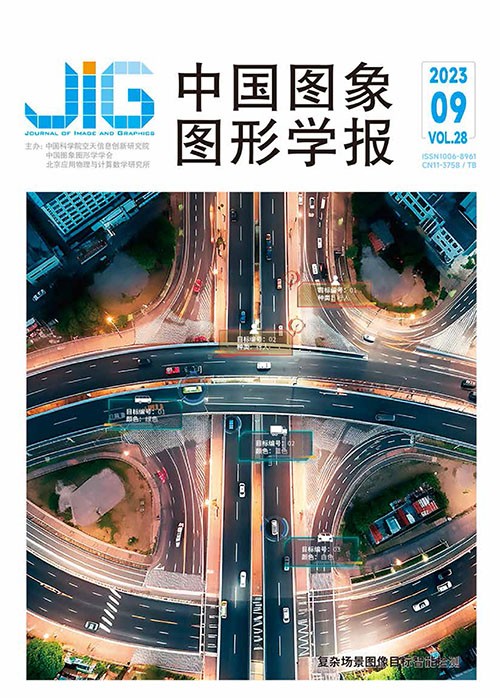
结合内外先验知识的低照度图像增强与去噪算法
摘 要
目的 现有大多数低照度图像增强算法会放大噪声,且用于极低照度图像时会出现亮度提升不足、色彩失真等问题。为此,提出一种基于 Retinex(retina cortex)的增强与去噪方法。方法 为了增强极低照度图像,首先利用暗通道先验原理估计场景的全局光照,若光照低于 0.5,对图像进行初始光照校正;其次,提出一种 Retinex 顺序分解模型,使低照度图像中的噪声均体现在反射分量中,基于分解结果,利用 Gamma 校正求取增强后的噪声图像;最后,提出一种基于内外双重互补先验约束的去噪机制,利用非局部自相似性原理为反射分量构建内部先验约束,基于深度学习,为增强后的噪声图像构建外部先验约束,使内外约束相互制约。结果 将本文算法与 6 种算法比较,在 140 幅普通低照度图像和 162 幅极低照度图像上(有正常曝光参考图像)进行主观视觉和客观指标评价比较,结果显示本文方法在亮度提升、色彩保真及去噪方面均有明显优势,对于普通低照度图像,BTMQI(blind tone-mappedquality index)和 NIQE(natural image quality evaluator)指标均取得次优值,对于极低照度图像,NIQMC(no-referenceimage quality metric for contrast distortion)、峰值信噪比(peak signal-to-noise ratio,PSNR)和结构相似性(structural simi-larity index,SSIM)3 种指标均取得最优值,其他算法的峰值信噪比在 8~18.35 dB,结构相似度在 0.3~0.78,而本文算法可达到 18.94 dB 和 0.82,优势明显。结论 本文算法不仅可以增强不同光照条件下的低照度图像,还可以有效去除图像中的噪声,效果稳定。
关键词
Low-light image enhancement and denoising with internal and external priors
Du Shuangli, Dang Hui, Zhao Minghua, Shi Zhenghao(School of Computer Science and Engineering, Xi'an University of Technology, Xi'an 710048, China) Abstract
Objective Low-light image enhancement has been studied extensively in the past few decades as one of the most challenging image processing problems.The images taken in low-light conditions usually contain extremely dark areas and unexpected noise.Many impressive methods, including cognition-based and learning-based approaches, have been proposed to improve image brightness and recover image details and color information.Remarkable enhancement results have been achieved by deep-learning-based techniques.Low-light and norm-light image pairs are required for enhancement methods based on supervised learning.However, no unique or well-defined norm-light ground truth exists.In addition, the models trained by a direct image-to-image transformation manner, even with generative adversarial networks, tend to show a bias toward a certain range of luminance values and scenes.Approaches based on the retina cortex(Retinex)represent a branch of cognition-based methods.However, they tend to amplify the noises hidden in dark images.Some attempts for noise suppression have been introduced.They focus on utilizing the internal prior in the input image to distinguish the noise from the image texture.The denoising performance is limited, and the image texture is often removed together with noise.This scenario leads to a blurry background.Additionally, most of these enhancement methods are designed for generally low-light images.If they are used for images with extremely low light, insufficient brightness improvement and obvious color deterioration are produced.This study proposes a low-light image enhancement and denoising method to address these issues by combining the internal and external priors.Method We regard extremely low-light image enhancement as a two-stage illumination correction task.First, the global illumination in a scene is estimated based on the well-known dark channel prior.If the global illumination is lower than 0.5, the input image is regarded as an extremely low-light image, and an initial brightness correction is performed for the image.If the global illumination is greater than or equal to 0.5, the input image is a generally low-light image;thus, no further processing is required.Second, a sequential Retinex decomposition model is proposed to decompose a low-light image into an illumination component multiplied by a reflectance component.An L1-norm regularization term on the illumination gradient is applied under the assumption that it is spatially piecewise smooth.Unlike approximating the illumination layer to a pre-estimation, our method aims to approximate the illumination layer to the low-light image in the RGB color space.Then, all noises are supposed to be contained in the reflectance layer.Based on the Retinex decomposition result, the enhanced noise image is produced with Gamma correction.Finally, a denoising technique is proposed based on a dual, complementary prior constraint.This technique utilizes a nonlocal selfsimilarity property to construct the internal prior for the reflection component.The deep learning technique is also utilized to construct the external prior constraint for the enhanced noise image.Then, the internal and external priors restrict each other.The proposed denoising model can be solved by an alternating optimization strategy.Result We compare the proposed method with six existing enhancement algorithms, including two Retinex-based traditional approaches, two deep learning approaches, and two Retinex-based learning approaches, to verify its effectiveness.We select 140 generally lowlight images(global illumination > 0.5)from the commonly used datasets, including DICM, LIME, and ExDark.We also select 162 extremely low-light images(global illumination < 0.15)from the LOL dataset for testing.For the generally lowlight images, no well-exposed normal-exposure image exists for reference.Both visual evaluation and quantitative evaluation are provided.Three nonreference quality assessment metrics, including blind tone-mapped quality index(BTMQI), no-reference image quality metric for contrast distortion(NIQMC)and natural image quality evaluator(NIQE), and two full-reference metrics, including peak signal-to-noise ratio(PSNR)and structural similarity index measure(SSIM), are utilized for evaluation.The visual comparisons show that our method has advantages in brightness improvement, color fidelity, and denoising.For the generally low-light images, the quantitative comparisons show that our method achieves the second-best results for BTMQI and NIQE.For NIQMC, the result of our method is close to the results of the two Retinexbased traditional methods.For extremely low-light images, our method achieves the best results for NIQMC, PSNR, and SSIM.The PSNR values obtained by other algorithms range from 8 to 18.35 dB, and their SSIM values range from 0.3 to 0.78.In comparison, our algorithm can reach 18.94 dB and 0.82 for PSNR and SSIM, respectively, showing noticeable advantages.Qualitative and quantitative experimental results show that the proposed algorithm can enhance low-light images under different illumination conditions and effectively remove noise hidden in images.Moreover, its performance is relatively stable.Conclusion This paper proposes a novel Retinex-based low-light image enhancement and denoising method, which can be used for generally and extremely low-light images.The irreconcilable problem between the brightness increase and the color distortion for extreme low-light enhancement task is effectively solved by transforming one extremely low-light image into a generally low-light image.A dual, complementary constraint is constructed based on the internal and external priors to remove the amplified noise.The experiments demonstrate that the constraint can balance noise removal and texture preservation, making the enhanced image edge clear.
Keywords
Retinex decomposition low-light image enhancement dark channel prior environmental illumination estima- tion dual complementary prior constraint denoising
|



 中国图象图形学报 │ 京ICP备05080539号-4 │ 本系统由
中国图象图形学报 │ 京ICP备05080539号-4 │ 本系统由